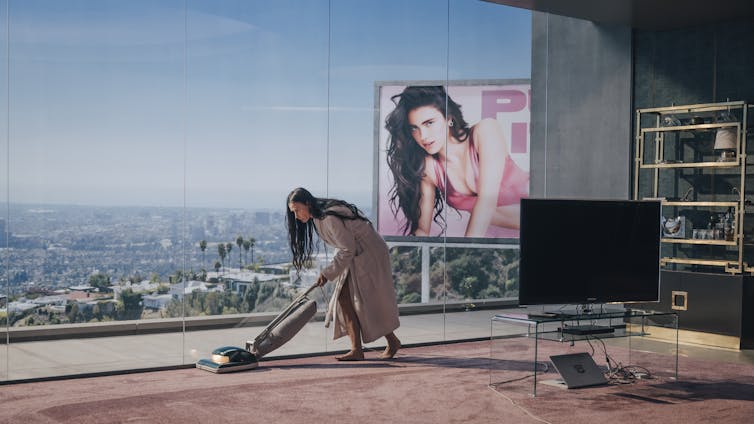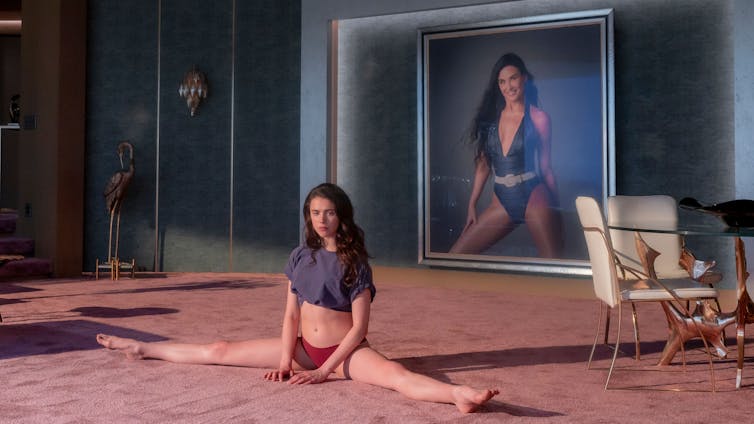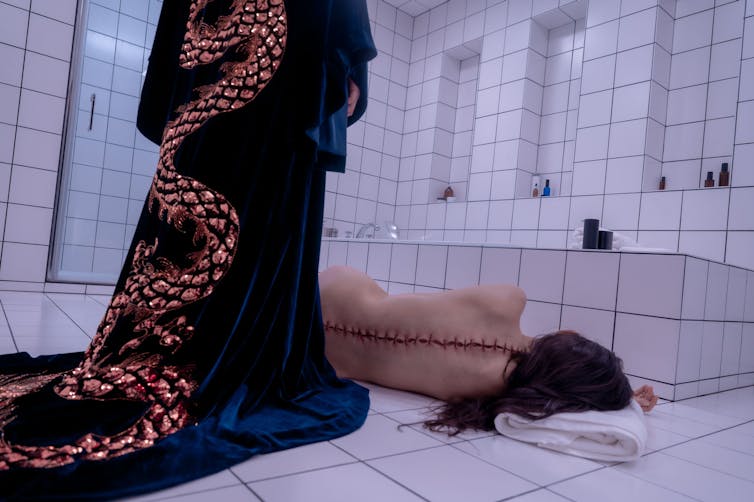The Substance is a satirical body-horror and science fiction film that examines the obsession with female beauty and youth and the invisibility of ageing women write Sara Oscar and Cherine Fahd.

Madman Entertainment
In The Substance, the career of former actor Elisabeth Sparkle (Demi Moore) is diminished to daytime aerobics instructor on a television network. On her 50th birthday, she is made redundant by a network executive, Harvey (Dennis Quaid), who tells her “renewal is inevitable”.
There is no future for ageing women.
In her redundancy, Elisabeth has an accident. At the hospital, she is passed a note from a handsome young doctor for a black-market drug known as “the substance” that promises to generate a younger version of a person with a single injection. Desperate for youthful relevance, Elisabeth takes the substance and gives birth to a stronger version of herself, Sue (Margaret Qualley).
There are strict rules for taking “the substance”. One rule is that Elisabeth and Sue must share time, taking it in turns to live in the world every seven days. While one lives, the other sleeps so their cells may regenerate.
Another rule is they must remember they “are one”, despite being two separate bodies who can never spend time together.
Elisabeth does not re-experience youth through Sue – even though they share the same DNA and are, according to the rules, “one”.
This is where things start to go horribly wrong for Elisabeth/Sue.
Taking aim at the male gaze
The Substance is a satirical body-horror and science fiction film underpinned by feminist critique. The film examines the obsession with female beauty and youth, the invisibility of ageing women, and the voracious consumption of women’s bodies in Hollywood’s star system.
In interviews, director Coralie Fargeat takes aim at both the beauty myth – the belief that a woman’s value is tied to her appearance – and the male gaze – a way of visualising the female body as an object to be looked at for and by men.
 The Substance examines the obsession with female beauty and youth. Madman Entertainment
The Substance examines the obsession with female beauty and youth. Madman Entertainment
Many of the scenes in the film reflect this critique using hammed-up, hyper-sexualised slow pans across female body parts: wet lips, pert breasts, toned butts. Such scenes mimic the male gaze familiar in popular culture, from Hollywood films to twerking arses in music videos.
Yet Fargeat moves beyond mimicry. Throughout the film, she uses mirrors, photographs, cameras and television to draw our attention to the male gaze and to show the trouble – and horror – that ensues when appearances and reality do not align.
The film depicts injecting, vomiting, bleeding, eating, self-harm and violent and grotesque transformations of the body to create psychological tension and disgust.
The uncanny culture of the copy
The Substance has an acute awareness of the motif of the double, through archetypes and psychoanalytic concepts such as the split psyche, mirroring and the evil twin.
In the opening scene, an egg yolk is injected with a syringe and split into two. This doubling recurs quite literally when Elisabeth takes the substance and “gives birth” to the so-called “better version of herself”.
Sigmund Freud’s unheimlich, or the uncanny, haunts the premise of the film.
The uncanny refers to the unsettling feeling that arises when something familiar becomes eerily unfamiliar, often revealing repressed fears or hidden aspects of the self.
 Sigmund Freud’s concept of the uncanny haunts the premise of the film. Madman Entertainment
Sigmund Freud’s concept of the uncanny haunts the premise of the film. Madman Entertainment
Elisabeth, seeing a billboard image of Sue, has a complex response. It exacerbates her self-loathing and envy. Sue triggers Elisabeth’s deepest fears.
As Sue gains increasing fame, Elisabeth’s invisibility and irrelevance only increases – undermining the whole point of taking “the substance”.
Neither woman can reckon with the uncanny spectre of the other in photographs and television footage.
Mother–daughter nexus
For Sue, seeing photographs of Elisabeth triggers disgust — so much so that the mural-sized photograph of Elisabeth in the apartment they share gets hidden, like Oscar Wilde’s The Picture of Dorian Gray.
We see further feminist archetypes such as the “old hag” and the “unruly daughter”. The mother–daughter nexus is prevalent. The dynamic of love and conflict, attraction and disgust cannot be underplayed.
Sue is both Elisabeth’s salvation and her doom. Sue represents the younger self to which Elisabeth can never return. Sue also threatens to erase Elisabeth’s life by repeatedly breaking the seven-day rule. This has devastating effects on Elisabeth’s sleeping body, which instantly ages.
 Sue is both Elisabeth’s salvation and her doom. Madman Entertainment
Sue is both Elisabeth’s salvation and her doom. Madman Entertainment
Over time, this inflicts the worst kinds of physical horrors on Elisabeth’s body.
The more Elisabeth becomes consumed by Sue’s perfection, the more grotesque her own body becomes, until, in the end, she is a sci-fi mash-up of The Lord of the Rings’ Golem, Star Wars’ Palpatine, and David Lynch’s Elephant Man.
The film pulls from these iconic figures of deformity and monstrosity to underscore how society views ageing women’s bodies: the derision of menopause, the so-called “change” not as a natural part of life, but as something to be feared and reviled.
The scenes of Elisabeth gorging and cooking over a cauldron with wiry grey hair, and fisting a raw chicken carcass accompany scenes of the body’s mutilation.
The film also questions how we consume the female body and how women are conditioned to mutilate themselves for youth and beauty. The false economy of appearances reminds us that beneath the make-up, injectables, botox and fillers, there is always going to be an imperfect body in a process of natural decay.
The Substance offers no redemption for Elisabeth. Her pursuit of a younger, more beautiful self is the horror. Her final realisation is that the more she tries to escape her body, the more she is trapped by it.
Sara Oscar, Senior Lecturer, Visual Communication, School of Design, University of Technology Sydney and Cherine Fahd, Associate Head of School, School of Design, University of Technology Sydney
This article is republished from The Conversation under a Creative Commons license. Read the original article.

